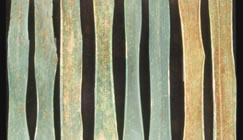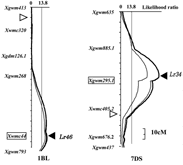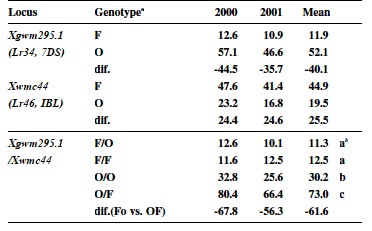Tagging of slow rusting genes for leaf rust, Lr34 and Lr46, using microsatellite markers in wheat
Description
[Objectives]
Leaf rust is the most serious disease in wheat. The use of resistant cultivars is very important in achieving sustainable wheat production in developing countries for economic and environmental reasons. Since racespecific genes may be overcome through genetic shifts or new form of virulence in the pathogen population, durable resistance genes are of great interest to wheat breeders. Slow-rusting genes such as Lr34 and Lr46, which are widely used in the CIMMYT breeding program, have been identified to be race-nonspecific and durable. However, the contribution of each gene is small and easily affected by environmental factors, and therefore it is difficult to identify the genes due to their race non-specificity. Tagging these genes with molecular markers increases the efficiency of selecting the resistance genes and facilitates marker-assisted selection for leaf rust.
[Results]
A doubled haploid (DH) population was produced from cv. Fukuho-komugi x cv. Oligoculm by means of wheat x maize crosses. One hundred and seven DH lines were genotyped for 595 markers, such as microsatellites, RFLP and RAPD. Of the 443 markers mapped, 343 markers were used to construct a framework map to perform QTL analysis for leaf rust resistance in this population. Leaf rust severity was recorded in the field in 2000 and 2001, in Sonora State, Mexico (Fig. 1).
Two QTLs for leaf rust severity were detected on 7DS and 1BL by means of composite interval mapping (CIM, Fig. 2). These QTLs were considered to be due to the effects of the known slow-rusting genes, Lr34 and Lr46. The QTL analysis also indicated that Lr34 was derived from Fukuho-komugi, while Lr46 was derived from Oligoculm. These QTLs accounted for about 40% and 26% of the total variation, respectively.
Table 1 shows genetic effects of the two marker loci, Xgwm295.1 on 7DS and Xwmc44 on 1BL, which were linked to these QTLs. The mean differences in leaf rust severity were 40.1% for Xgwm295.1 and 11.3% for Xwmc44. Resistant genotype (F/O) was 61.6% more resistant than the susceptible genotype (O/F), and 19.9% more resistant than the overall population mean. Moreover, genotyping of the DH lines using these molecular markers aided in distinguishing the lines with Lr34 and Lr46 from those with only Lr34. These results indicate that the molecular marker loci Xgwm295.1 and Xwmc44 facilitate the identification of Lr34 and Lr46 in breeding materials and contribute to the pyramiding of leaf rust resistant genes.
This study was conducted as part of a collaborative program between the Biological Resources Division, JIRCAS, and the Applied Biotechnology Center, CIMMYT, from January 1998 to January 2002.
Figure, table
-
Fig. 1. Symptoms of leaf rust-infected leaves. From left to right (two leaves each): Fukuho-komugi (Lr34), Oligoculm (Lr46), resistant and susceptible DH lines. -
Fig. 2. Likelihood ratio (LR) contour by composite interval mapping for QTL detection of leaf rust severity on chromosome 1B long arm and 7D short arm. Bold contour indicates LR by joint analysis of data for the years 2000 and 2001. LR thresholds, equivalent to LOD=2.5, are 11.5 for a single year and 13.8 for joint analysis. Short arms are toward the top. indicates centromere.
indicates centromere. -
Table 1. Genotypic effects of flanking loci on leaf rust severity (%).
a F, O and dif. indicate Fukuho-komugi, Oligoculm and genotypic difference between F and O genotypes. F and O are resistant and susceptible for Lr34, and susceptible and resistant for Lr46, respectively.
b Mean values with different letters are significantly different (P<0.05).
- Affiliation
-
Japan International Research Center for Agricultural Sciences Biological Resources Division
- Classification
-
Technical A
- Term of research
-
FY2001 (FY1997-2001)
- Responsible researcher
-
SUENAGA Kazuhiro ( Biological Resources Division )
BAN Tomohiro ( Biological Resources Division )
- ほか
- Japanese PDF
-
2001_04_A3_ja.pdf789.1 KB
- English PDF
-
2001_04_A4_en.pdf69.11 KB



